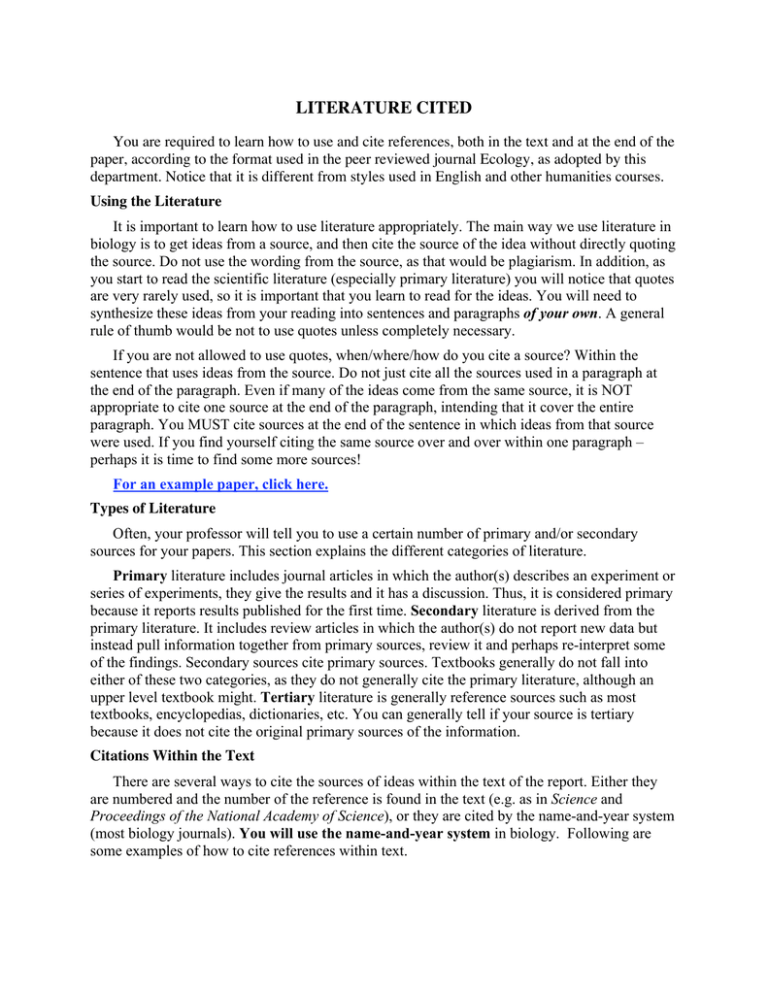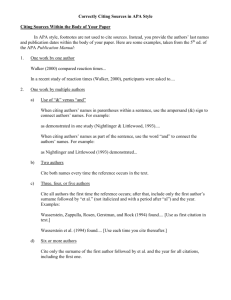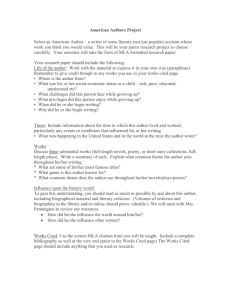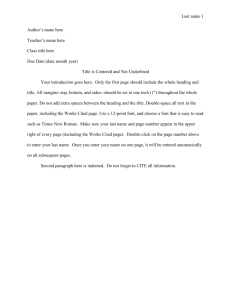LITERATURE CITED
advertisement

LITERATURE CITED You are required to learn how to use and cite references, both in the text and at the end of the paper, according to the format used in the peer reviewed journal Ecology, as adopted by this department. Notice that it is different from styles used in English and other humanities courses. Using the Literature It is important to learn how to use literature appropriately. The main way we use literature in biology is to get ideas from a source, and then cite the source of the idea without directly quoting the source. Do not use the wording from the source, as that would be plagiarism. In addition, as you start to read the scientific literature (especially primary literature) you will notice that quotes are very rarely used, so it is important that you learn to read for the ideas. You will need to synthesize these ideas from your reading into sentences and paragraphs of your own. A general rule of thumb would be not to use quotes unless completely necessary. If you are not allowed to use quotes, when/where/how do you cite a source? Within the sentence that uses ideas from the source. Do not just cite all the sources used in a paragraph at the end of the paragraph. Even if many of the ideas come from the same source, it is NOT appropriate to cite one source at the end of the paragraph, intending that it cover the entire paragraph. You MUST cite sources at the end of the sentence in which ideas from that source were used. If you find yourself citing the same source over and over within one paragraph – perhaps it is time to find some more sources! For an example paper, click here. Types of Literature Often, your professor will tell you to use a certain number of primary and/or secondary sources for your papers. This section explains the different categories of literature. Primary literature includes journal articles in which the author(s) describes an experiment or series of experiments, they give the results and it has a discussion. Thus, it is considered primary because it reports results published for the first time. Secondary literature is derived from the primary literature. It includes review articles in which the author(s) do not report new data but instead pull information together from primary sources, review it and perhaps re-interpret some of the findings. Secondary sources cite primary sources. Textbooks generally do not fall into either of these two categories, as they do not generally cite the primary literature, although an upper level textbook might. Tertiary literature is generally reference sources such as most textbooks, encyclopedias, dictionaries, etc. You can generally tell if your source is tertiary because it does not cite the original primary sources of the information. Citations Within the Text There are several ways to cite the sources of ideas within the text of the report. Either they are numbered and the number of the reference is found in the text (e.g. as in Science and Proceedings of the National Academy of Science), or they are cited by the name-and-year system (most biology journals). You will use the name-and-year system in biology. Following are some examples of how to cite references within text. 1. When there is one author: “Palisano (1990) showed that . . .” or “Previous work (Palisano 1990) shows . . .” 2. When there are two authors, use the last names of both authors when citing, as in “Harlan and Zigler (2009) reported . . .” or “as previously reported (Harlan and Zigler 2009) . . .” 3. When there are more than two authors, use only the last name of the first author, followed by et al., as in “Reid et al. (2008) report that . . .” or “Some investigators (Reid et al. 2008) have reported . . .” NOTE the format of et al.: it is italicized and there is a period after al. The expression et al. is Latin for “and others.” 4. When there are two or more references showing similar results, list the references chronologically, separated by a semicolon: “This has been previously reported (Haskell and Adhikari 2009; McGrath and Binkley 2009) . . .” Literature Cited Page At the end of the paper you will have a Literature Cited section. Please note that ALL literature used in the body of the paper must be listed; and that ONLY those sources actually cited should be listed here at the end. The format of your citations must conform to the following formats. Pay close attention to what is or is not capitalized or italicized, where periods, commas, colons and semicolons appear, and the order in which the information (such as authors and their initials, etc.) appears in the citation. The format of citations must be followed precisely; down to the commas and the use of italics and bold. With regard to Authors’ names – use initials only, do not give full first and/or middle names. Also, the authors must be in the proper order. The first author listed on a paper or book must be the first one you list within the citation. In your Literature Cited section, alphabetize entries according to the last name of the first author of each work cited. If you have multiple sources from the same author(s), arrange by year (earlier first); if you have multiple sources from the same author(s), in the same year, add a lower case letter to identify each when citing in the text and when making the bibliographical entry (Jones 1983a; Jones l983b). In addition to the formatting discussed above, Latin names, including species names, are italicized. Note that the last names of all authors of a paper are included in the Literature Cited section, even though the names of only one or at most two authors are cited in the text of the report (e.g.: “Lemoine et al. 2006” would be found in the text, but “Lemoine, D., J.P. Evans, and K. Smith. 2006. A landscape-level GIS analysis of streamside management zones on the Cumberland Plateau. Journal of Forestry 104:125-131.” would be found in the Literature Cited section.) Do NOT use et al. in the literature cited list at the end of the paper. Specific styles for different kinds of literature are given below. Please pay close attention to detail. For an example article from the journal Ecology (whose formatting we have adopted) click here. Standard Journal Article Single author Generic format: Author #1, A.A. Year. Title of article. Title of Journal Volume:pages. Example: Palisano, J.R. 1990. The origin and role of confronting cisternae in selected fetal mouse and rat tissues. Cell Bio. Internat’l. Reports 14:1025-1032. Two or more authors (separate last and next to last author names by ‘and’) Generic format: Author #1, A.A., B.B. Author #2, (etc.) and C.C. Author #X. Year. Title of article. Title of Journal Volume:pages. Example: Berner, N.J., P.L. Else, A.J. Hulbert, B. Mantle, R.L. Cramp and C.E. Franklin. 2009. Metabolic depression during estivation does not involve remodeling of membrane fatty acids in two Australian frogs. Journal of Comparative Physiology B 179(7):857 – 866. Books Note: the title of the book is neither underlined nor italicized. Personal Author(s) (e.g. the entire book is written by the author(s)) Generic format: Author #1, Author #2 and Author #3. Year. Title of book. Edition (if applicable). Publisher, City, Country. Example: Eason, G., C.W. Coles, and G.Gettingby. 1980. Mathematics and statistics for the bio-sciences. 5th ed. Ellis Horwod Limited, West Sussex, England. Edited book (e.g. a book in which different authors contributed individual chapters) Generic format for citing an individual chapter: Chapter Author #1 and Chapter Author #2. Year. Title of chapter. Pages XX-YY in Editor(s). Title of book. Edition (if applicable). Publisher, City, Country. Example: Hammerschmidt, R and R.L. Nicholson. 1999. A survey of plant defense responses to pathogens. Pages 55-71 in Agrawal, A.A., S. Tuzun and E. Bent, editors. Induced plant defenses against pathogens and herbivores: biochemistry, ecology and agriculture. APS Press, St. Paul, USA. Example for citing the entire book (rather than an individual chapter): Wood, R.K.S., editor. 1982. Active defense mechanisms in plants. Plenum Press, New York, USA. Items From The World Wide Web1 You should be cautious when looking for sources on the internet. It is important that articles used are from reputable, peer reviewed web sites. Remember, any Billy Bob and Betty Jo can put anything they want to, information or misinformation, on the world wide web. Note that articles that are accessed online from journals that are also available in print version (e.g. Ecology, Conservation Biology, Molecular Biology of the Cell) should be cited according to the printed journal format given above, and not as a web document. Only periodicals that are available only as an electronic source should be cited as web documents. When citing web sites, include the author(s), year (if available), title of web page, retrieval date of the information and the Universal Resource Locater (web address) or URL. Generic format: Author, A.A. Year. Title of work. Retrieved month day, year. URL. Note: If the web site does not have an obvious author, cite the author as Anonymous Example: Anonymous. Year. Title of work. Retrieved month day, year. URL. Brown, J. 1996. Bugs in the News. Retrieved October 21, 1996. http://falcon.cc.ukans.edu/~jbrown/bugs/html. 1 Pechenik, J.A. A Short Guide to Writing About Biology. 3rd Edition. Longman Press, N.Y. 1997.




